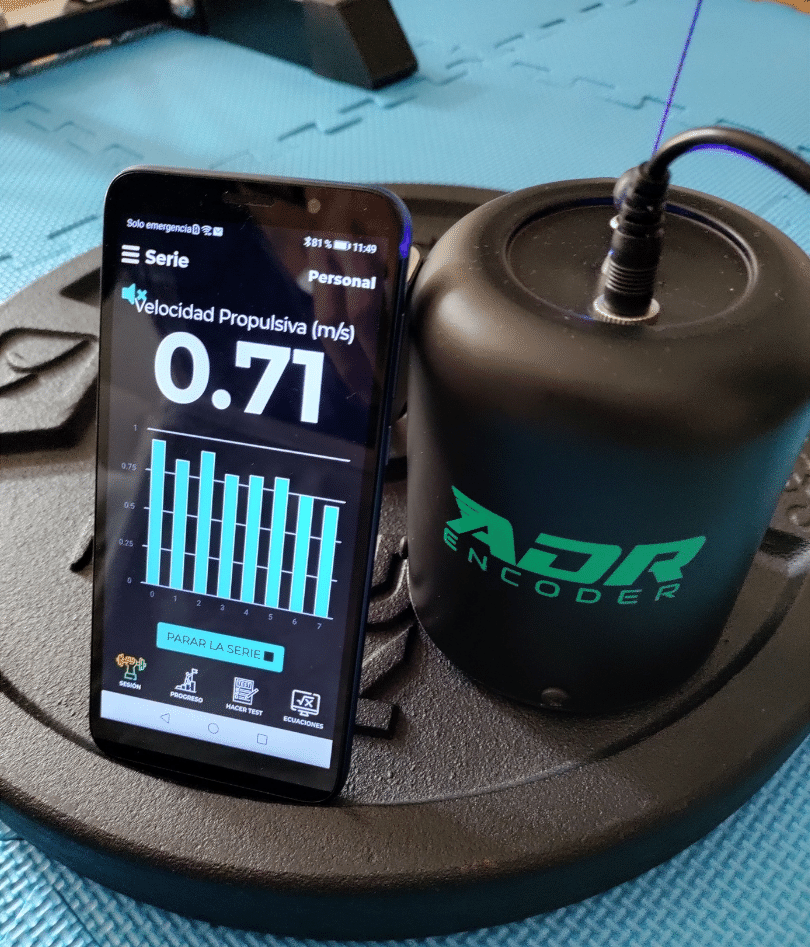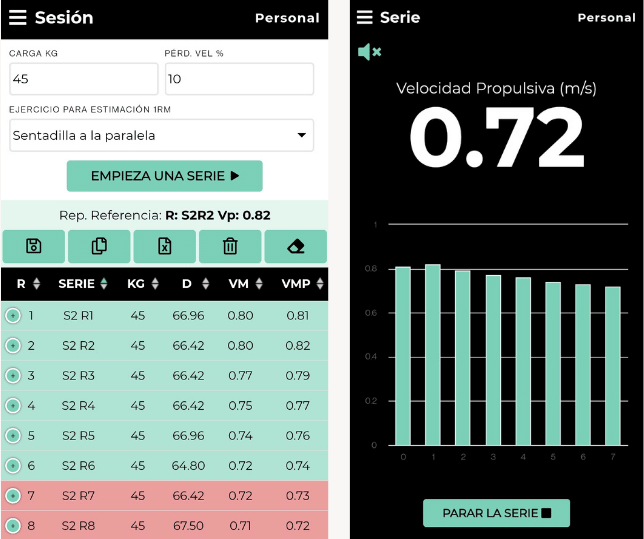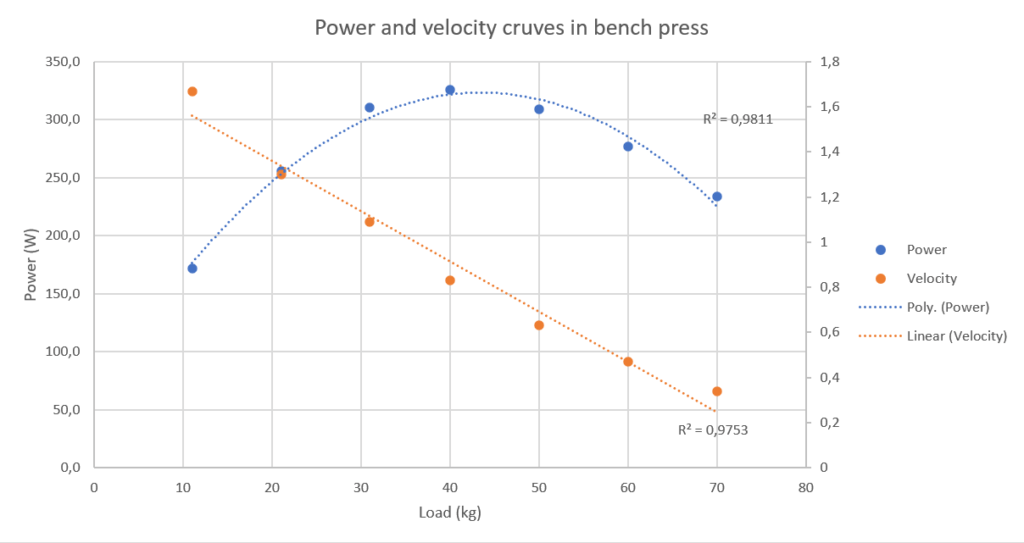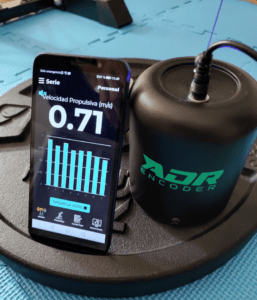Table of Contents
- What is velocity-based training?
- Why is it necessary to measure speed in strength training?
- Why should I use this method?
- How do you train with it?
- How the assessment is done and possible results
- Advantages in endurance sports of VBT compared to the classic method of %RM
- Limiting factors of VBT
- Bibliography
What is velocity-based training?
Velocity based training consists of a strength training program performed at the maximum speed possible for all the repetitions, while recording the speed of each one. For technical reasons of the measurement, this type of training can only be performed in exercises with pulleys on machines or with free weights with a barbell. This is due to the fact that the speed measurement is carried out using a linear encoder, which is a device with a cable that records the speed at which the cable moves, therefore, it has to be connected somewhere. There are other measurement methods, such as accelerometers or video analysis tools, but they have a lower precision and reliability. Our recommendation, always use an encoder such as ADR encoder or Vitruve.

ADR encoder connected to the app
Why is it necessary to measure speed in strength training?
Normally in the gym, when talking about strength, reference is made to the loads lifted (mass) and not to the actual force applied to the movement. This is because, according to Newton’s second law: F=ma (force = mass * acceleration). Therefore, for the same mass (kg lifted in a squat, for example) there may be different values of force depending on the acceleration experienced by the bar (or how fast it moves). In fact, more than twice the force is produced by lifting the same load at twice the speed. This is so since they experience a square relationship, that is, a speed twice as high would imply four times as much force (in theory, assuming that there is no deceleration phase at the end of the movement and that the two movements are performed in the same way). In addition, by measuring the speed of the repetition and knowing the load lifted, we can also calculate the peak power of each repetition. Check this to learn about forces that affect cycling.
Why should I use this method?
When training with the speed measurement, the athlete is encouraged to perform all the repetitions at maximum speed, therefore, the quality of the training ends up being higher since the repetitions are performed with higher strength and power values. What’s more, just by having instant feedback it has been seen in scientific studies increments of session performance by higher motivated athletes. Nagata and his team [1] studied the differences in the VBT in relation to the feedback received by the athlete. Some received immediate feedback, others visual feedback, others feedback on the average of repetitions, and others without feedback. In this study they found that the group that received immediate feedback experienced the greatest adaptations at the strength level.
It is also very common for cyclists to ask: How many repetitions do I have to do? Well, in this case the encoder can also help us. When planning a session, the number of repetitions to be performed is usually estimated, but the athlete finishes each set not when that number of repetitions is completed, but when a specific speed loss is reached (depending on the objectives). The athlete could even be told only the load (kg) to use and the target speed loss and he/she would already know when to stop each set. With this method it is possible that repetitions decrease during each set, but what is achieved is that all of them are carried out at a speed very close to the maximum.

Example of a squat training set using VBT
One of the key features of this training method is that you usually work with repetition ranges far from muscle failure. Only by performing half of the possible repetitions or less at maximum speed, notable strength improvements are already achieved [2]. This fact leads to less fatigue and faster recovery.
Another very useful advantage that an encoder offers you is that of being able to assess the level of pre-training fatigue of the cyclist with a known load. Let’s say for example that cyclist A can lift 50kg in a squat at a maximum speed of 1m/s. If this cyclist arrives at training and after warming up tries to squat with 50kg and performs it at 0.98m/s, which is very close to his maximum, it means that he is in good condition to perform the training. On the other hand, if his speed is 0.9 or 0.8m/s when performing the squat, it will indicate that he has a high level of fatigue and perhaps the best option would be to change the type of training or give him rest that day so that he can recover. right.
Finally, working with small ranges of speed loss, greater force adaptations are achieved and, above all, greater gains in jumping and sprinting compared to other methods in which attempts are made to get close to muscle failure, either with the objective of hypertrophy or maximum strength [3].
How do you train with it?
The most important factor in velocity-based training is the importance of maximal volitional speed. The athlete has to try to perform all the repetitions at the maximum intensity possible, for this a high concentration and a good state of recovery are required. A good recovery guideline would be about 2 minutes of rest between sets, with which you should be sufficiently recovered to face the next set. The rest of the guidelines in relation to volume per series and total series, can be the same as with other methods. For example, in cycling a good workout might consist of 3×6-8 squat reps + 3×6-8 Bulgarian squat + 3×6-8 hip thrust all with a 10-20% speed loss. In the case of cycling, a sport in which strength demands are not very high, performing half of the possible repetitions would be enough to obtain the aforementioned improvements, this would be equivalent to a 10-20% loss of speed.
In the previous points, speed loss has been discussed, but what is this concept really? Well, the loss of speed is the difference in speed between the fastest repetition of the set or training session and the last repetition of the set. This difference is calculated as a percentage, therefore, for an exercise in which the maximum speed is 1m/s, you would be working with a 10% loss of speed if you stop the series when you reach below 0.9m/s and with a 20% loss if it stops when reaching below 0.8m/s.
How the assessment is done and possible results
The assessment of VBT training can be done day by day by seeing how the maximum speeds evolve with respect to different loads, but for a more precise evaluation it is necessary to carry out a test periodically to see the complete picture.
This test is performed on certain loads for each athlete, for example: someone who has a 1RM (maximum load that can be lifted in one repetition) of 100kg could perform the load-speed test with 20, 40, 60 and 80 kg. To facilitate the analysis of the data, it would be advisable to always carry out the same loads, being able to add some more when the athlete gains strength. If the assessment is for a sport in which the maximum force demands are very important, it is possible to get closer to the 1RM. After an adequate warm-up, ideally two repetitions should be performed at maximum speed with each load and the best records of each load should be recorded. Resting about two minutes between charges to ensure full recovery.
For the results to be reliable and comparable over time, it is important to ensure high reproducibility by standardizing the test as much as possible, limiting the factors that may produce different measurements in future tests. For example, a change in the speed of the eccentric phase would produce different speed measurements, so pausing for 1 second before the concentric phase would be a good solution to limit this factor. Another important factor to take into account is to ensure similar distances in the execution of the exercise (measure given by the encoder). Finally, it is also important to ensure a previous state of low fatigue and using the same equipment.

Results of a bench press assessment using the Load-velocity curve, from 13% to 90% of 1RM
As can be seen in the example graph above with the data from the test carried out, the power curve can also be drawn and thus determine the working ranges for maximum power outputs. In this case, the power peak would be around 40kg with an optimal working range of between 30 and 50kg. It is interesting to note that the load-speed relationship is always linear and the power-load relationship parabolic.
When repeating this test several possibilities can be found, the first that there are no changes, the second that the speed has been improved against all the loads of the test, the third that the speed has improved only with certain loads or, the last and surely the least common, that some speed records have worsened and others have improved. It could also be that all the load’s speed worsened, but with strength training for cyclists that doesn’t tend to happen unless training volume is has been greatly reduced or stopped. On the other hand, with other strength assessment methods such as a 5RM or 1RM test, you only have two possible results: either it has improved or worsened, against the five possibilities mentioned above. This gives you a much more precise description of the performance status of the athlete, being able to assess the entire strength-speed spectrum.
We find two measures of speed, both equally valid, which are VMD (average speed) and VMP (maximum speed). Another interesting measure that must be taken into account also is the distance. A change of which, in the same exercise and with the same loads, can vary the speed of the exercise. It can also be used to assess the technical consolidation of a movement (very different distances in the same series would indicate different technical executions) or a progression in the range of movement (if the execution distance of an exercise is increased over time).
Advantages in endurance sports of VBT compared to the classic method of %RM
With VBT you can adjust the relative load in each session without having to do the full test, just by seeing the speed achieved with a specific load. Therefore, the weight corresponding to the same relative load (% of maximum) can be adjusted daily.
A particularity of the VBT is that for each exercise there is usually a speed associated with the 1RM, for example, in the squat this speed is close to 0.3 m/s. Therefore, if an athlete is performing a repetition close to 0.3m/s means you are either very close to muscle failure or you are lifting a load very close to your 1RM. This speed in a deadlift is 0.15m/s and in bench press 0.17m/s. Therefore, just by knowing the speed of the first repetition of a movement, it is possible to know how many more repetitions could be performed approximately.
In relation to performance itself, greater strength gains have been observed with VBT, and especially greater sprint and jump gains when training with low speed losses (<20%) [3]. By always working in high speed ranges, this type of training makes it ideal for sports in which speed or jumping is very important. At the point where this type of training would not be very useful is the case of hypertrophy. Since for hypertrophy you have to get close to failure, you would have to work with high speed losses and to hypertrophy it is not necessary that the repetitions are performed at maximum speed, which might be even detrimental.
Already mentioned in previous sections, but another advantage is that with this method the same force adaptations can be achieved, but with less fatigue. Something that favors the cyclist since they can carry out their training on the bike with less muscle fatigue and less perception of effort.
Limiting factors of VBT
- Requires a linear encoder, a tool not available to everyone
- Requires higher levels of concentration in each training session
- Difficult to use/interpret for athletes without a coach
- You must always carry the encoder with you
Bibliography
[1] Nagata, A. et al. (2020). The Effect of Augmented Feedback Type and Frequency on Velocity-Based Training-Induced Adaptation and Retention. Journal of Strength and Conditioning Research.
[2] Rodriguez-Rosell, D. et al. (2020). Velocity-based resistance training: impact of velocity loss in the set on neuromuscular performance and hormonal response. Applied Physiology, Nutrition, and Metabolism.
[3] Pareja-Blanco, F. et al. (2016). Effects of velocity loss during resistance training on athletic performance, strength gains and muscle adaptations. Scandinavian Journal of Medicine & Science in Sports.


